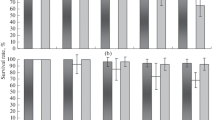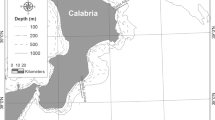Abstract
Laboratory studies on the reproductive cycle of the planktonic copepod Temora stylifera, collected from the Gulf of Naples between October 1987 and March 1988, showed that females oscillated between a light and dark gonadal condition. Histological preparations indicated that the dark condition corresponded to a ripe stage of oogenesis as compared to the light or unripe maturation state of primary oocytes. The number of eggs released within 24 h was strongly dependent on the reproductive status of the female at the time of incubation. Light unfed females rarely reverted to a dark or ripe condition and egg deposition in such cases was almost always zero. Dark females produced eggs within 24 h under all experimental food conditions, reverting from dark to light soon after egg deposition. Successively, the length of the interclutch period was strongly dependent on the type of food present. A high percentage of infertile eggs was almost always present. We suggest that short-term studies, not taking into consideration the condition of gonads at the time of incubation, will underestimate potential egg production rates. Females maintained for longer than three or four days produced mainly infertile eggs. After remating, females reinitiated the production of fertile eggs but egg viabilities never reached 100% hatching success, indicating poor efficiency in the fertilization of mature oocytes. We hypothesize a possible cause and effect relationship between egg viabilities and seasonal fluctuations in population densities.
Similar content being viewed by others
Literature cited
Abou Debs, C., Nival, P. (1983). Etude de la ponte et du developpment embryonnaire en relation avec la temperature et la norriture chez Temora stylifera Dana (Copepoda: Calanoida). J. exp. mar. Biol. Ecol. 72: 125–145
Ambler, J. W. (1985). Seasonal factors affecting egg production and viability of eggs of Acartia tonsa Dana from East Lagoon, Galveston, Texas. Estuar. cstl Shelf Sci. 20: 743–760
Arnaud, J., Brunet, M., Mazza, J. (1978). Studies on the midgut of Centropages typicus (Copepod, Calanoid). Cell Tissue Res. 187: 333–353
Beckman, B. R., Peterson, W. T. (1986). Egg production by Acartia tonsa in Long Islang Sound. J. Plankton Res. 8: 917–925
Blades-Eckelbarger, P. I. (1986). Aspects of internal antomy and reproduction in the Copepoda. Proc. 2nd int Conf. Copepoda, Ottawa. Syllogeus 58: 26–50
Blades-Eckelbarger, P. I., Younbluth, M. J. (1984). The ultrastructure of oogenesis and yolk formation in Labidocera aestiva (copepoda: Calanoida). J. Morphol. 179: 33–46
Conover, R. J. (1967). Reproductive cycle, early development, and fecundity in laboratory populations of the copepod Calanus hyperboreus. Crustaceana 13: 61–72
Dagg, M. (1978). Estimated, in situ, rates of egg production for the copepod Centropages typicus (Kroyer) in the New York Bight. J. exp. mar. Biol. Ecol. 34: 183–196
Dagg, M. J., Clarke, M. E., Nishiyama, T., Smith, S. L. (1984). Production and standing stock of copepod nauplii, food items for larvae of the walleye pollock Theregra chalcogramma in the southern Bering Sea. Mar. Ecol. Progr. Ser. 19: 7–16
Heinle, D. R. (1970). Population dynamics of exploited cultures of calanoid copepods. Helgoland. wiss. Meeresunters. 20: 360–372
Hinkley, R. E., Wright, B. D., Lynn, J. W (1986). Rapid visual detection of sperm-egg fusion using the DNA-specific fluorochrome Hoechst 33342. Dev. Biol. 118: 148–154
Ianora, A., Scotto di Carlo, B. (1988). Observations on egg production rates and seasonal changes in the internal morphology of mediterranean populations of Acartia tonsa and Centropages typicus. In: Boxshall G. A., Schminke H. K. (eds.) Biology of Copepods. Hydrobiologia 167/168: 247–253
Katona, S. K. (1975). Copulation in the copepod Eurytemora affinis (Poppe, 1880). Crustaceana 28: 89–95
Kimmerer, W. J. (1984). Spatial and temporal variability in egg production rates of the calanoid copepod Acrocalanus inermis. Mar. Biol. 78: 165–169
Marshall, S. M., Orr, A. P. (1952). On the biology of Calanus finmarchicus VII: factors affecting egg production. J. Mar. biol. Ass. U.K. 30: 527–547
Marshall, S. M., Orr, A. P. (1972). The Biology of a Marine Copepod. Springer Verlag, Berlin
Moore, E., Sander, F. (1976). Quantitative and qualitative aspects of the zooplankton and breeding patterns of Copepods at two Caribean Coral Reef stations. Estuar. cstl Mar. Sci. 4: 589–607
Parrish, K. K., Wilson, D. F. (1978). Fecundity studies on Acartia tonsa (Copepoda: Calanoida) in standardize culture. Mar. Biol. 46: 65–81
Razouls, S. (1974). Maturité sexuelle et fécondité chez les femelles de Temora stylifera, copépode pélagique (Copepoda Calanoidea). Archs Zool. exp. gén. 115: 387–399
Razouls, S. (1975). Fécondité, maturité sexuelle et différenciation de l'appareil génital des femelles de deux Copépodes planctoniques: Centropages typicus et Temora stylifera. Pubbl. Staz. zool. Napoli 39: 297–306
Razouls, S. (1982). Etude expérimental de la ponte de deux copépodes pélagiques Temora stylifera et Centropages typicus. II. Dynamique des pontes. Vie Milieu 32: 11–20
Runge, J. A. (1984) Egg production of the marine, planktonic copepod, Calanus pacificus Brodsky: laboratory observations. J. exp. mar. Biol. Ecol. 74: 125–145
Runge, J. A. (1985). Relationship of egg production of Calanus pacificus to seasonal changes in phytoplankton availability in Puget Sound, Washington. Limnol. Oceanogr. 30: 382–396
Scotto di Carlo, B., Tomas, C. R., Ianora, A., Marino, D., Mazzocchi, M. G., Modigh, M., Montresor, M., Petrillo, L., Ribera d'Alcalà, M., Saggiomo, V., Zingone, A. (1985). Uno studio integrato dell'ecosistema pelagico costiero del Golfo di Napoli. Nova Thalassia 7: 99–128
Uye, S.-I. (1981). Fecundity studies of neritic calanoid copepods Acartia clausi Giesbrecht and A. steueri Smirnov: a simple empirical model of daily egg production. J. exp. mar. Biol. Ecol. 50: 255–271
Watras, C. J. (1983). Reproductive cycles in diaptomid Copepods: effects of temperature, photocycle, and species on reproductive potential. Can. J. Fish. aquat. Sciences 40: 1607–1613
Watras, C. J., Haney, J. F. (1980). Oscillations in the reproductive condition of Diaptomus leptopus (Copepoda: Calanoida) and their relation to rates of egg-clutch production. Oecologia 45: 94–103
Williamson, C. E., Butler, N. M. (1987). Temperature, food and mate limitation of copepod reproductive rates: separating the effects of multiple hypotheses. J. Plankton Res. 9: 821–836
Wilson, D. F., Parrish, K. K. (1971). Remating in a planktonic marine calanoid copepod. Mar. Biol. 9: 202–204
Author information
Authors and Affiliations
Additional information
Communicated by M. Sara, Genova
Died tragically at sea during a cruise
Rights and permissions
About this article
Cite this article
Ianora, A., Scotto di Carlo, B. & Mascellaro, P. Reproductive biology of the planktonic copepod Temora stylifera . Mar. Biol. 101, 187–194 (1989). https://doi.org/10.1007/BF00391457
Accepted:
Issue Date:
DOI: https://doi.org/10.1007/BF00391457




